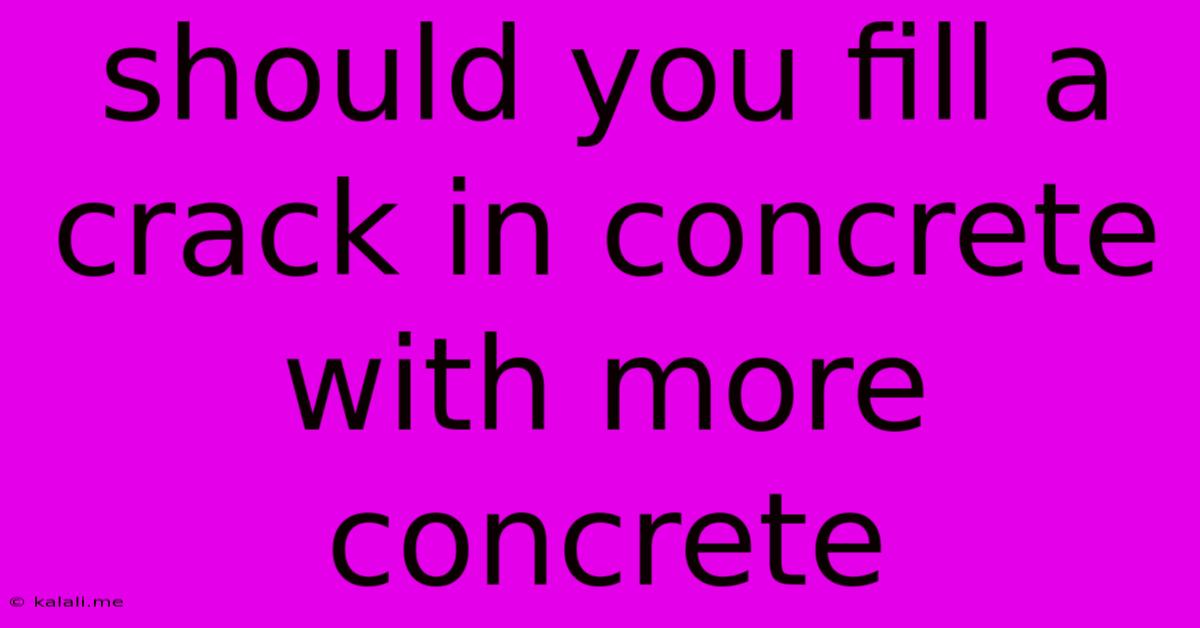Should You Fill A Crack In Concrete With More Concrete
Kalali
Jun 05, 2025 · 3 min read

Table of Contents
Should You Fill a Crack in Concrete With More Concrete? A Comprehensive Guide
Cracks in concrete are a common sight, especially in driveways, patios, and foundations. While they might seem like a minor inconvenience, ignoring them can lead to more significant structural problems down the road. This article will explore whether filling a crack with more concrete is the best solution, examining different types of cracks and the appropriate repair methods. Understanding the cause of the crack is key to choosing the right repair technique, ensuring longevity and preventing further damage.
Identifying the Type of Crack
Before you even consider filling the crack, it's crucial to understand what kind of crack you're dealing with. Different cracks require different approaches. Here are some common types:
- Hairline Cracks: These are thin, superficial cracks that don't significantly compromise the structural integrity of the concrete. Often caused by temperature changes or shrinkage, these generally don't need extensive repair.
- Settlement Cracks: These cracks often appear as larger, more pronounced fissures, indicating movement in the underlying soil or foundation. This type of crack might require more than just a simple filler.
- Shrinkage Cracks: These cracks occur during the curing process of the concrete, as it dries and shrinks. They usually appear as a network of smaller cracks.
- Erosion Cracks: These are often caused by water damage and freeze-thaw cycles. They tend to be more irregular in shape and can be quite deep.
When More Concrete is (and isn't) the Answer
Filling a crack with more concrete, often called patching, is a viable option for some types of cracks, but not all. Here's a breakdown:
When it's a good idea:
- Small, superficial cracks: For hairline cracks and minor shrinkage cracks, patching with concrete can be an effective solution. This is a relatively simple DIY project. Ensure you properly clean the crack before applying the patch.
When it's NOT a good idea:
- Large or deep cracks: For significant cracks, especially those that indicate settlement or structural issues, simply filling them with concrete is a temporary fix at best. The underlying problem needs to be addressed. Ignoring a larger crack can lead to more extensive damage.
- Cracks showing signs of movement: If the crack is widening or changing, it indicates ongoing movement. Patching will likely crack again. Professional assessment is needed to determine the cause of the movement.
- Cracks accompanied by other signs of damage: Look for spalling (chipping) or crumbling concrete. This suggests more serious damage than a simple crack. A qualified concrete professional will be able to identify the extent of damage and recommend the proper course of action.
Alternative Repair Methods
Depending on the type and severity of the crack, other repair methods might be more appropriate:
- Epoxy Injection: This method is ideal for cracks that are deep or structurally significant. Epoxy resin is injected into the crack, filling it and strengthening the concrete.
- Concrete sealant: For smaller cracks, a high-quality concrete sealant can prevent water penetration and further damage.
- Caulking: This is a flexible sealant often used for cracks around edges and joints. It is not structural.
Conclusion
Whether or not you should fill a crack in concrete with more concrete depends entirely on the nature of the crack. For minor, superficial cracks, patching is a viable option. However, for larger, more significant cracks, a simple patch is often a temporary, ineffective solution. Identifying the cause of the crack and choosing the appropriate repair method is crucial to maintaining the structural integrity and longevity of your concrete surfaces. If you are unsure about the severity of the crack or the best repair method, consulting a qualified concrete contractor is always recommended. They can provide a professional assessment and recommend the most appropriate and lasting solution.
Latest Posts
Latest Posts
-
Charge A Car Battery With A Power Supply
Jun 07, 2025
-
How To Find Lost Car Keys
Jun 07, 2025
-
Did The Early Church Believe In The Rapture
Jun 07, 2025
-
Nest No Power To Rh Wire
Jun 07, 2025
-
How To Cite A Screenshot In Apa
Jun 07, 2025
Related Post
Thank you for visiting our website which covers about Should You Fill A Crack In Concrete With More Concrete . We hope the information provided has been useful to you. Feel free to contact us if you have any questions or need further assistance. See you next time and don't miss to bookmark.